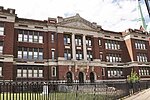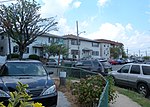Create Charter High School
CREATE Charter High School was a four-year public high school that operated under a charter granted by the New Jersey Commissioner of Education. The school was run independently of the Jersey City Public Schools since it opened in September 2001 and was shut down in June 2010 after receiving notice from Acting Commissioner of Education Bret Schundler that the charter would be withdrawn as the school had failed to achieve its goals, including having less than 5% of graduating seniors reaching the proficient level on the language arts and mathematics components of the High School Proficiency Assessment.CREATE Charter High School was a public school open to all students on a space-available basis. The school also had a middle school, CREATE Charter Middle School, and was the only high school in the county to do so. Offering a 195-day school year with a school day extending from 8:30 am to 3:30 pm, the school was founded by Jersey City Councilman Steve Lipski.
Excerpt from the Wikipedia article Create Charter High School (License: CC BY-SA 3.0, Authors).Create Charter High School
Greenville Avenue, Jersey City
Geographical coordinates (GPS) Address Nearby Places Show on map
Geographical coordinates (GPS)
| Latitude | Longitude |
|---|---|
| N 40.6963 ° | E -74.094 ° |
Address
Greenville Avenue 7
07305 Jersey City
New Jersey, United States
Open on Google Maps







